|
|
|
 |
| |
MI6 looks back at the road to production of the
first James Bond film and 007's onscreen parallels
to modern culture and politics…
|
|
James Bond In History (2)
20th June 2008
James Bond, the infamous secret agent,
has had immense popularity and sustainability as both
a character and a pop-icon. Over the
past 50 years the persona of James Bond has influenced fashion
and style, movies and television, art and even the way
people
behave. Previously
MI6 investigated the legacy of the literary character and his
Cold War ties. Continuing from Part
1, we delve into the history of 007's onscreen
legacy...
 James Bond In History (1) James Bond In History (1)
Screen Bonding
In the UK in the mid '50s, several production companies
were after 007. Foresight from companies such as United
Artists (an MGM division) meant that Bond was soon to be
under the microscope and later in front of the camera.
In 1954, the American TV organisation
CBS commissioned a small television production of "Casino
Royale". They hoped to piggyback on the success
of Bond novels and comic
strips. It starred American Barry
Nelson as Bond, and premiered in October 1954 as part of
the "Climax!" series of mini-features. The
TV rights to "Casino Royale" were brought
from Fleming for a mere $1000 and this 1-hour special
aired to
minimal success.
|
|
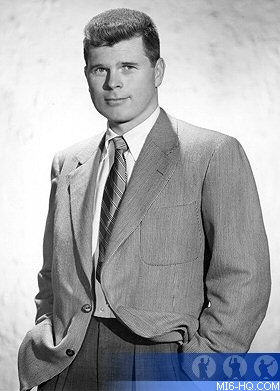 Above: Barry Nelson,
the first man to play 007 before the cameras... Above: Barry Nelson,
the first man to play 007 before the cameras...
|
Producing A Phenomenon
Ultimately it would take a big budget
and far more traditional sense of British class to turn
the cinematic James Bond into a household name. The two men
that
would transform
007 into a onscreen icon were
Harry Saltzman and Albert
R. Broccoli. Originally in separate partnerships, both expressed
an interest in the complete film rights to Bond. In 1958, Broccoli
set up a meeting between his partner, Irving Owen and Fleming,
hoping to cut a deal for the Bond rights. Owen left the meeting
empty handed shortly after arriving after telling Fleming
that he didn’t think his novels were good enough - even
for television. In 1960, Saltzman approached Fleming and successfully
brought the rights to James Bond for $50,000. That same year
United
Artists expressed an interest with Fleming’s agent, who
had to turn them down.
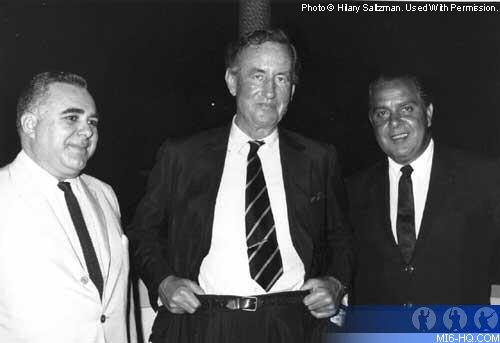
Above: Producers Harry Saltzman and Albert Broccoli with Bond author
Ian Fleming
|
The same happened to Broccoli and his enquiries,
after separating from Owen. However, another producer holding
the
Bond rights would not deter Albert R. Broccoli. After tracking
down Saltzman he tried to purchase the rights but Saltzman wouldn’t
have it - he wanted to form a partnership with Broccoli and
produce James Bond together.
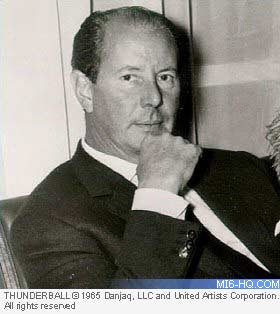 |
|
With the successful acquisition of Bond,
two companies were formed: Danjaq, a Swiss corporation
taking
Dana Broccoli and Jacqui Saltzman’s collective first
names that would hold the rights to the rights to James
Bond and
all the novel content, save Casino Royale, and second
company, EON Productions, would be the front company and
physically
produce the Bond films.
In the ‘60s the movie business was
in the cinema company’s pockets. They would finance,
manage and take a large chunk of a profit, just on a handshake.
So, when the newly formed Danjaq approached United Artists
they agreed in under an hour to produce the first Bond picture
- provided it was "Dr. No".
Left: Legendary Bond
director Terence Young is called in to direct 007...
|
Pleased with their deal, the Bond Producers hired
scriptwriters and set about finding a director. Popular filmmakers
of the time: Guy Green, Ken Hughes and even Guy Hamilton all turned
the job down. It would take the bold and modern Terence
Young to
direct Bond to success.
Jamaican Roots
Assembling the principal cast for "Dr. No" meant
finding a 30-ish, suave yet brutal actor Terence Young could
transform into a super-spy. Popular actors of their time
Richard Johnson, Carry Grant and even Roger
Moore - who was
reluctantly tied to his infamous TV programme "The Saint"
- were approached but Dana Broccoli found unknown Sean
Connery in "Darby O’Gill and the Little People".
After a short meeting with the production team Connery
agreed to
play Bond.
Terence Young was tasked with crafting Sean
Connery in the image of Fleming’s Bond. He immediately
took Sean to tailors "Turnbull & Asser" -
who today, with a little help from Bond, are a top "Savile-Row-esque"
tailor.
Other roles are filled more easily but just
two weeks out from shooting the lead "Bond girl",
Honey Ryder was yet to be cast. Scripts were urgently sent
to several actresses but it was Ursula Andress who agreed
to play the role without even meeting the producers.
Right: "Dr. No"
introduced two relative unknowns: Sean Connery and Ursula
Andress. Today, both are household names. |
|
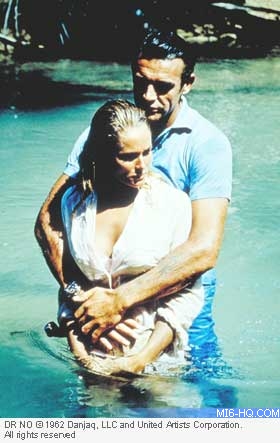 |
With Terence Young behind the camera the crew headed
for Jamaica, where Fleming wrote and set the novel. At the time
of shooting Jamaica was in the process of transition from a British
colony back to a native Government. While it chose to remain a member
of the British Commonwealth, Jamaica was one of the countries ruled
by the English the longest. It must have been ironic for some that
one of the biggest British film icons began in Jamaica.

Above: The location
of Fleming's Goldeneye is now a luxury resort |
|
Nevertheless, it would be unfair to state
that the Bond production didn’t give back to the nation
that supported it. Monty Norman wrote a Jamaican number-one
hit performed popular group "Byron Lee and the Dragonaires"
for "Dr. No". To this day Byron Lee and his group
remain one of the most successful Jamaican bands and still perform Barry's number.
007 did not just support Jamaica with music;
the economy flourishes with tourism - its biggest national
industry. Bond fans flock to Kingston, Port Royale and of
course Goldeneye - Ian Fleming’s Jamaican home,
now a major resort and tourist attraction. |
Pushing The Limits
"Dr. No" famously pushed the boundaries of filmmaking
standards. In the editing room Peter Hunt cut a modern and unconventional
film. Breaking all the rules, Hunt cut over movement and action
(something avoided as an unspoken rule by past editors) with the
concept of keeping a fast-paced and interesting thriller.
Ken Adam, now a film legend, became famous
designing the world around 007 with modern and extravagant
sets. The interior of Dr. No’s lair may seem over the
top in modern times, but at the time Adam’s design
was the height of imagination and creativity. Thanks to Adam,
it is easy for fans to watch the history of the world's fashion
develop around 007...
The same went for the iconic "gun-barrel"
that rolls across the beginning of every James Bond picture.
Maurice Binder used a pinhole camera, a real gun barrel
and
stunt man Bob Simmons to devise the iconic Bond opening -
a technical filmmaking concept never considered until Binder's
vivid imagination was set to work.
|
|
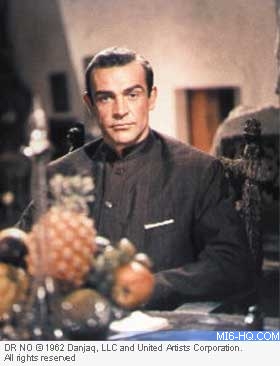 Above: Sean Connery
on the set of Dr. No's dining room in the 1962 film... Above: Sean Connery
on the set of Dr. No's dining room in the 1962 film...
|
In every respect James Bond films pushed
the boundary of filmmaking technique, creative concepts and
nothing topped Bond for sheer entertainment.
Related Articles
 Dr. No - Movie Index
Dr. No - Movie Index
 Sean
Connery Biography Sean
Connery Biography
|
|
|